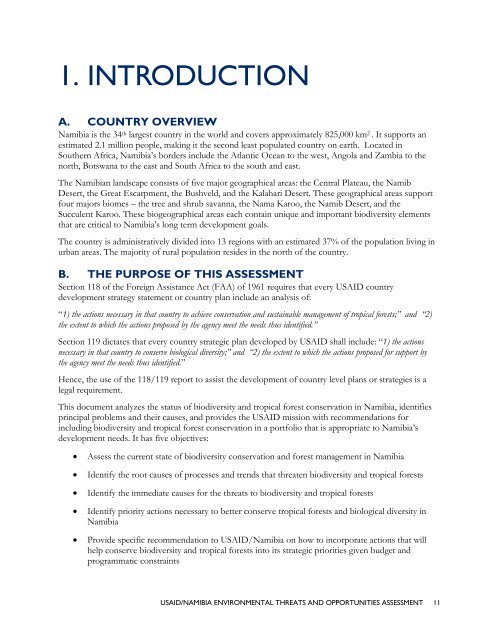usaid/nambia environmental threats and opportunities assessment
usaid/nambia environmental threats and opportunities assessment
usaid/nambia environmental threats and opportunities assessment
Create successful ePaper yourself
Turn your PDF publications into a flip-book with our unique Google optimized e-Paper software.
1. INTRODUCTION<br />
A. COUNTRY OVERVIEW<br />
Namibia is the 34 th largest country in the world <strong>and</strong> covers approximately 825,000 km 2 . It supports an<br />
estimated 2.1 million people, making it the second least populated country on earth. Located in<br />
Southern Africa, Namibia’s borders include the Atlantic Ocean to the west, Angola <strong>and</strong> Zambia to the<br />
north, Botswana to the east <strong>and</strong> South Africa to the south <strong>and</strong> east.<br />
The Namibian l<strong>and</strong>scape consists of five major geographical areas: the Central Plateau, the Namib<br />
Desert, the Great Escarpment, the Bushveld, <strong>and</strong> the Kalahari Desert. These geographical areas support<br />
four majors biomes – the tree <strong>and</strong> shrub savanna, the Nama Karoo, the Namib Desert, <strong>and</strong> the<br />
Succulent Karoo. These biogeographical areas each contain unique <strong>and</strong> important biodiversity elements<br />
that are critical to Namibia’s long term development goals.<br />
The country is administratively divided into 13 regions with an estimated 37% of the population living in<br />
urban areas. The majority of rural population resides in the north of the country.<br />
B. THE PURPOSE OF THIS ASSESSMENT<br />
Section 118 of the Foreign Assistance Act (FAA) of 1961 requires that every USAID country<br />
development strategy statement or country plan include an analysis of:<br />
“1) the actions necessary in that country to achieve conservation <strong>and</strong> sustainable management of tropical forests;” <strong>and</strong> “2)<br />
the extent to which the actions proposed by the agency meet the needs thus identified.”<br />
Section 119 dictates that every country strategic plan developed by USAID shall include: “1) the actions<br />
necessary in that country to conserve biological diversity;” <strong>and</strong> “2) the extent to which the actions proposed for support by<br />
the agency meet the needs thus identified.”<br />
Hence, the use of the 118/119 report to assist the development of country level plans or strategies is a<br />
legal requirement.<br />
This document analyzes the status of biodiversity <strong>and</strong> tropical forest conservation in Namibia, identifies<br />
principal problems <strong>and</strong> their causes, <strong>and</strong> provides the USAID mission with recommendations for<br />
including biodiversity <strong>and</strong> tropical forest conservation in a portfolio that is appropriate to Namibia’s<br />
development needs. It has five objectives:<br />
<br />
<br />
<br />
<br />
<br />
Assess the current state of biodiversity conservation <strong>and</strong> forest management in Namibia<br />
Identify the root causes of processes <strong>and</strong> trends that threaten biodiversity <strong>and</strong> tropical forests<br />
Identify the immediate causes for the <strong>threats</strong> to biodiversity <strong>and</strong> tropical forests<br />
Identify priority actions necessary to better conserve tropical forests <strong>and</strong> biological diversity in<br />
Namibia<br />
Provide specific recommendation to USAID/Namibia on how to incorporate actions that will<br />
help conserve biodiversity <strong>and</strong> tropical forests into its strategic priorities given budget <strong>and</strong><br />
programmatic constraints<br />
USAID/NAMIBIA ENVIRONMENTAL THREATS AND OPPORTUNITIES ASSESSMENT 11

















